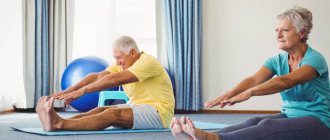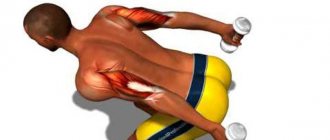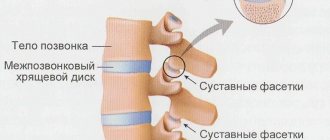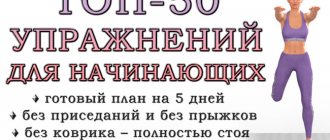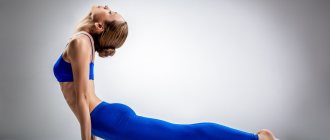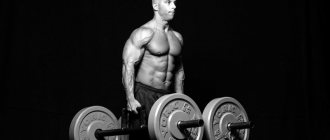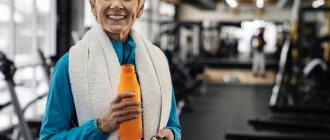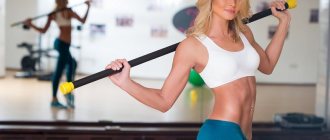Intense physical activity is not recommended for older people. However, keeping the body in good shape is extremely necessary. To do this, you can do a warm-up after waking up. This will have a positive effect on overall health, strengthen the joints of the legs and arms, increase muscle tone, and improve the functioning of the heart and blood vessels.
We invite you to take advantage of our version of morning exercises after 60 years, which consists of two rounds, warm-up and main. The exercises are simple and suitable for everyone.
What are the benefits of doing this exercise:
- strengthening and maintaining health, giving vigor and energy;
- restoration or preservation of elasticity of muscles and joints;
- improvement of posture, gait, reduction of stoop, flat feet;
- positive effect on the nervous system, heart and blood vessels.
Safety regulations
Physical education in retirement
Alexey Korochkin, a researcher at the Department of Exercise Therapy and Sports Medicine of the Russian State Medical University, tells how to properly engage in physical education at an older age.
- If you're just starting out, use the back of a chair or table for support, and have someone stand next to you for support.
- Gradually stop using objects for support: first hold on to them with one hand, then only with your fingers.
- If you stand firmly on your feet and easily perform all the exercises, proceed to perform them with your eyes closed.
- Don't take long breaks from studying. These exercises can be done every day, but at least 3-4 times a week.
Features of exercise therapy in old age
Rehabilitation specialists at the Yusupov Hospital do not provide exercise therapy for pensioners if the following contraindications exist:
- diseases of internal organs in the acute stage, accompanied by severe insufficiency of their function;
- aneurysm of the heart, aorta and large vessels;
- involutional mental disorders with pronounced changes in memory, impaired orientation in space and time, inadequate psycho-emotional reactions to external stimuli;
- severe muscle atrophy;
- gross dystrophic and destructive changes in the musculoskeletal system, significantly limiting the range of movements and preventing physical therapy exercises.
For patients over 70 years of age, a set of exercise therapy exercises is selected exclusively individually. Classes are held under strict medical supervision in a mode that does not exceed normal household loads. For elderly people, the most acceptable and easily dosed forms of exercise therapy are morning hygienic exercises, dosed walking and therapeutic exercises.
The exercise therapy instructor studies the previously mastered and familiar set of exercises for the patient and makes appropriate changes. Morning exercises are carried out in a group method with musical accompaniment. When selecting exercises, exercise therapy instructors pay attention to the simplicity and accessibility of performing the complex, excluding strength, isometric and complex coordination exercises. The basis of the complex is made up of elements that include small muscle groups. Measured efforts alternate with relaxation and breathing exercises. The duration of classes does not exceed 15-20 minutes.
A feature of the construction of a physical therapy complex for pensioners is the long duration of the introductory and final parts. The main part of the lesson should be no more than 40% of the total time. Exercise therapy instructors build a set of exercises so that different muscle groups are activated sequentially. Between individual exercises, increase the intervals and pauses for rest. Exercises with strength elements, holding the breath, with static tension and associated with sudden movements in the joints are excluded from the complex. The final part of the lesson necessarily includes relaxation exercises. After physical therapy, the patient rests for one and a half hours.
When prescribing various forms of physical therapy, rehabilitologists take into account the total load as a result of exercise therapy, household stress during the day and treatment procedures. In older people, the increase in workload occurs more slowly than in young people, and subjective improvement in health occurs earlier than improvement in objective indicators. At the Yusupov Hospital, for medical monitoring of the health status of elderly patients, an electrocardiogram is periodically recorded, Holter blood pressure monitoring, and echocardiography are performed.
Back leg raise
This exercise helps strengthen the buttocks and lower back muscles that are important for maintaining balance.
1. Stand next to a table or chair with your feet shoulder-width apart. 2. Lean forward slightly towards the support, holding onto it with your hands. 3. Slowly lift one leg back without bending your knee and pointing your toes out. 4. Stay in this position for one second, then slowly lower your leg to the floor. 5. Repeat with the other leg. Perform the exercise 8-10 times. Use ankle weights if necessary. Gymnastics for the elderly
The physical activity of older people differs from what they had in their youth and adulthood. Expert Marina Makarova shows simple exercises that you need to do to maintain mobility.
The influence of exercise therapy on the body of an elderly person
An effective method of pathogenetic therapy for diseases in the elderly is exercise therapy. For older people, a set of exercises is selected individually. Therapeutic exercise is carried out with the aim of improving the function of vital organs and systems (respiratory, cardiovascular, digestive, nervous, endocrine) and the musculoskeletal system. It increases the vital activity of the body and slows down the aging process.
The positive effect of physical exercise on the elderly body is due to the following factors:
- activation of redox and enzymatic processes;
- improving blood supply to tissues and organs;
- stimulation of compensatory reactions;
- increasing the body's adaptive capabilities to physical activity;
- creating a positive emotional background.
They help relieve neuropsychic stress, strengthen natural defense mechanisms, improve the body’s immunological reactivity and the function of the cardiorespiratory system.
Proper nutrition
A healthy and balanced diet will help maintain muscle tone. The menu should be dominated by protein products, because protein is the main building material for muscles.
Eating fresh vegetables and fruits will provide the body with essential vitamins and minerals. It is definitely recommended to introduce healthy fats into the diet, which maintain energy at the desired level and stimulate the production of hormones. It is best to get them from natural products: nuts, olive oil, sea fish.
An effective way to get pumped up at 50 is regular physical activity of varying intensity. Resistance training is considered the most effective. Go to the gym regularly. If this is not possible, you can train at home.
Pullover
Photo: AiF / Eduard Kudryavitsky
This exercise strengthens the pectoral muscles, back, upper shoulder girdle and develops the collar area.
Lie on your back on the sofa so that your hands, when you lower them behind your head, are completely above the empty space. Take the same position as for the previous exercise: knees bent, lower back pressed against the sofa, arms with dumbbells above your chest. Connect your fists and do not open them until the end of the exercise. Bend your elbows slightly so that they feel soft. Without bending further, lower both hands behind your head as deeply as possible and return to the starting position.
Repeat 2 times 15 times.
Walking and running
Running is useful at any age, but it is a big load on the body, so you should start training by selecting the load for your level of training and gradually increasing it.
Not everyone, after examination by a specialist, can fully engage in running training; for some, it is preferable to opt for race walking, which also has a positive effect on the body.
Running workouts help you lose excess weight; while running, you spend a lot of energy and calories to get a beautiful, toned figure. Constant movement strengthens the muscles and joints of the legs, trains endurance and has a positive effect on lung function. Runners are not afraid of heart attacks, strokes, and do not have to worry about their blood vessels.
During training, the hormone of happiness - endorphin - is also produced, and this guarantees a good mood and positive emotions. An evening jog will help improve your sleep, filling you with pleasant fatigue. You can do running wherever a person is, in an urban environment or while going on vacation in the summer of 2022.
About running as an adult in the video:
Swimming is also beneficial at any age. This includes strengthening the spine and joints, correcting poor posture, and strengthening bone tissue. During swimming, all muscle groups are involved, but the load on them is not felt as much due to the decrease in weight in the water. Therefore, even people with joint and leg problems can engage in such activities if they take precautions and consult a doctor.
Exercising in water has enormous benefits for the heart. With age, the problem of high blood pressure often becomes a concern - the heart muscle, in order to maintain the body, is forced to contract more often, which accelerates the heart rate. When swimming, the rhythm normalizes, the pressure returns to normal. Therefore, water is your best friend in the fight against diseases of the cardiovascular system.
When going on vacation in the summer of 2022 to a country with a warm sea, you should definitely take advantage of the moment and do a couple of exercises in the water, receiving additional positive emotions.
Optimal water training at any age lasts at least 30-40 minutes. This time is enough to swim 500 meters and perform several water aerobics exercises.
Safety measures in the pool
- if the water is not very warm, you should not stay in it for too long, get out at the first discomfort, especially if you have kidney pathologies and other diseases of the excretory system;
- You need to be careful when moving on the slippery floor in the pool - it is better to purchase slippers with non-slip soles in advance;
- It is better to choose a pool where there are staff who can provide assistance with training and other issues.
Conclusion
When thinking about what kind of sport to take up after 50 years and which one is best suited to individual needs and life characteristics, you should carefully study all the proposed options. Any activity has a positive effect on health, even the most insignificant, but it is better to pay attention to the disadvantages in addition to the advantages. Not everyone is suitable for heavy running loads or training with exercise machines; some prefer moderate walking or water aerobics.
Having studied the doctor’s testimony, choosing a convenient training regimen, and after 50 years you can live a full life, play sports and create positive energy around yourself, remaining young at heart.
Crunches
Photo: AiF / Eduard Kudryavitsky
Photo: AiF / Eduard Kudryavitsky
This classic exercise for the abdominals must be performed without lifting the lower back from the floor, otherwise there is a risk of damaging it.
Lying on your back, bend your knees and place your feet on a wall or rest your heels on the seat of a chair. Hands under the neck. As you exhale, lower your chin to your chest and stretch your forehead forward, twisting your back so that your shoulders and possibly your shoulder blades lift off the floor. In this case, the lower back should press harder to the floor. As you inhale, return to the starting position.
Repeat 2 times 10-15 times.
The health benefits of exercise for people 50+
- Because metabolism naturally slows with age, maintaining a healthy weight becomes challenging. Regular exercise helps speed up your metabolism and build muscle mass, helping your body burn more calories.
- People who exercise tend to have improved immunity and digestive health, increased blood pressure and bone density, and a reduced risk of chronic diseases (Alzheimer's, diabetes, obesity, heart disease and osteoporosis).
- Sports help improve mobility, flexibility and balance. Flexibility and posture improve, which in turn helps maintain balance and coordination, and reduces the risk of falls. Strength training also improves symptoms of chronic diseases such as arthritis.


